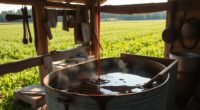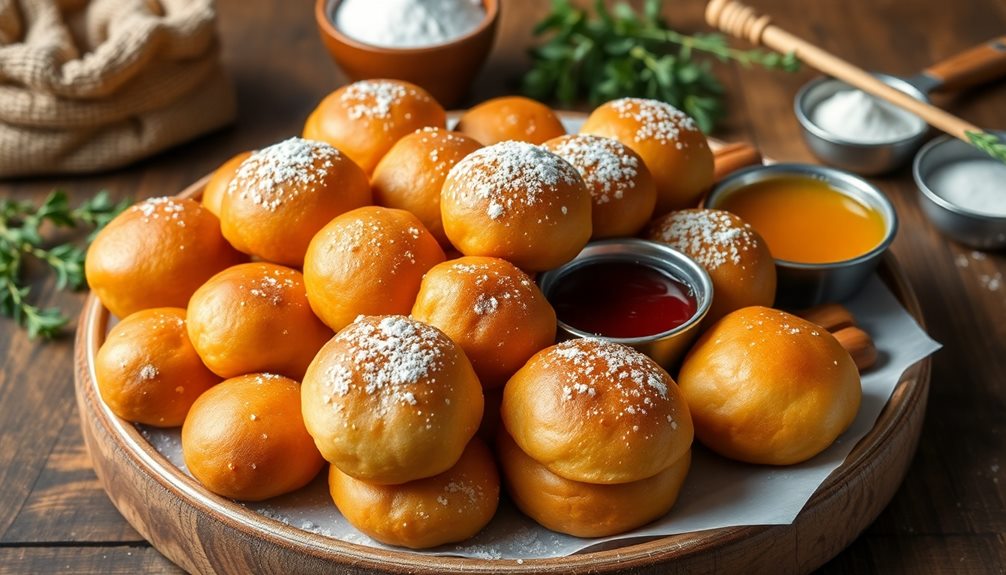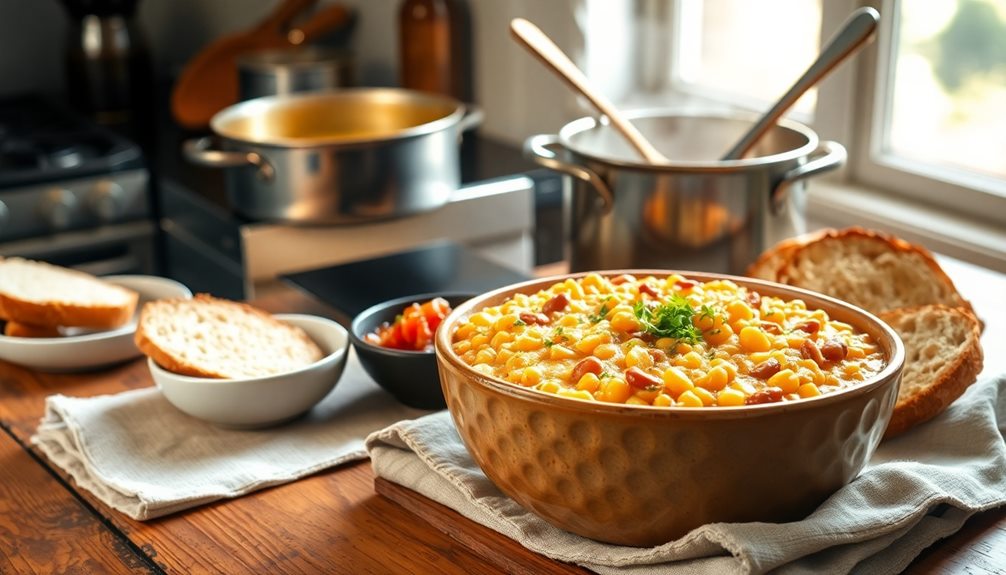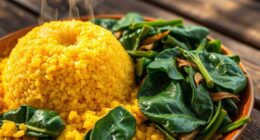If you’re comparing biltong and jerky, you’ll notice they’re dried using different methods that influence taste. Biltong is air-dried at room temperature after marinating in vinegar and spices, which gives it a tender, flavorful bite with hints of tang and spice. Jerky is dehydrated at low heat, resulting in a smoky, salty flavor with a firmer, drier texture. To understand how these techniques shape each snack, keep exploring the details behind their unique processes.
Key Takeaways
- Biltong is air-dried at room temperature, preserving moisture and developing complex, tangy flavors, unlike jerky’s low-temperature dehydration.
- Jerky is dehydrated at low heat, creating a dry, firm texture with smoky, salty flavors, whereas biltong remains more tender and moist.
- Biltong undergoes vinegar marination before air-drying, adding tang and spice, while jerky uses salt and seasonings with heat dehydration for concentrated flavor.
- The dehydration process in jerky results in a longer shelf life with a concentrated, smoky taste, while biltong’s gentle drying retains natural juices and nuanced flavors.
- Preservation techniques influence flavor profiles and textures, with biltong offering a richer, more complex taste due to air-drying and marination.

Have you ever wondered how biltong and jerky compare? These popular dried meats share similarities but also have distinct differences that influence their taste and texture. One of the main contrasts lies in their flavor profiles, which are shaped by the preservation techniques used during preparation. Biltong, originating from South Africa, typically features a richer, more complex flavor with hints of spice, vinegar, and sometimes even a touch of sweetness. Jerky, on the other hand, has a more straightforward, smoky, and salty taste, emphasizing the meat’s natural flavor. These differences come down to how each is cured and dried, affecting both taste and preservation.
When it comes to preservation techniques, biltong and jerky use different methods that influence their final flavor profiles and shelf life. Biltong is usually prepared by marinating strips of meat in vinegar, salt, sugar, and spices before air-drying at room temperature. This process allows the meat to develop a deep, savory flavor while the acidity from vinegar helps preserve it. The air-drying method is gentle, resulting in a tender, chewy texture that retains much of the meat’s original moisture. Jerky, in contrast, is typically made by marinating meat in a mixture of salt, sugar, and various seasonings, then drying it at low heat in a dehydrator or oven. This dehydration process is faster and often involves higher temperatures, which gives jerky its dry, firm texture and smoky taste. The heat also helps kill bacteria, extending shelf life without relying heavily on vinegar or fermentation.
The way these preservation techniques influence flavor is significant. Biltong’s curing process allows it to develop a more nuanced flavor with a balance of tanginess, spice, and meatiness. Its air-drying at ambient temperature preserves some of the meat’s natural juices, resulting in a tender yet chewy bite. Jerky’s high-heat dehydration creates a crisper, drier product with a more concentrated meat flavor, often complemented by smoky or sweet notes depending on the marinade. The difference in moisture content also impacts how each snack tastes and feels in your mouth. Biltong’s moisture makes it more tender and flavorful, while jerky’s dryness offers a more intense, long-lasting taste experience.
Frequently Asked Questions
Which Is Healthier: Biltong or Jerky?
When comparing which is healthier, biltong or jerky, you should consider their nutritional profiles and preservative content. Biltong often has less sugar and fewer preservatives, making it a slightly healthier choice. You can also check the nutritional comparison for protein and fat content. Opt for products with minimal additives, and always read labels. Overall, biltong may offer a cleaner, more natural snack option for health-conscious eaters.
Can I Make Biltong or Jerky at Home?
You can definitely make biltong or jerky at home with DIY dehydration. It’s a fun, rewarding process that allows you to customize flavors to your liking. Start with quality meat, season it to your taste, and control the drying environment. While it takes some time, you’ll enjoy fresh, flavorful snacks made exactly how you want, giving you full control over ingredients and dehydration methods.
How Long Can Dried Meat Products Be Stored?
You can typically store dried meat products for several months if you use proper preservation techniques. The shelf life depends on factors like humidity, temperature, and packaging. To maximize freshness, keep them in airtight containers or vacuum-sealed bags in a cool, dry place. Proper storage slows spoilage and maintains flavor, ensuring your dried meats stay tasty and safe to eat for up to 6-12 months, depending on the product.
Are There Vegetarian or Vegan Alternatives?
If you’re seeking vegetarian or vegan alternatives, you’ll find plenty of plant-based snacks and vegan protein options. These snacks mimic traditional dried meats’ flavors and textures using ingredients like soy, mushrooms, or jackfruit. You can enjoy flavorful, protein-rich options that suit your dietary choices. Exploring these plant-based snacks allows you to satisfy your snack cravings while sticking to vegan or vegetarian diets without sacrificing taste or texture.
What Are the Best Spices for Homemade Biltong or Jerky?
When choosing spice blends for homemade biltong or jerky, you want flavors that enhance the meat without overpowering it. Popular options include black pepper, coriander, garlic powder, and smoked paprika. These spices add depth and aroma, making your snack more flavorful. Experiment with different spice blends to find your perfect flavor profile, and don’t forget that salt acts as a vital flavor enhancer and preservative in your curing process.
Conclusion
When choosing between biltong and jerky, remember that their dehydration methods and flavors set them apart—biltong offers a tender texture with a tangy, beefy taste, while jerky is often drier with smoky notes. Did you know that the global dried meat market is projected to reach $4.5 billion by 2027? Whether you prefer one or the other, both provide a delicious, protein-packed snack to fuel your day. Try them both and discover your favorite!










